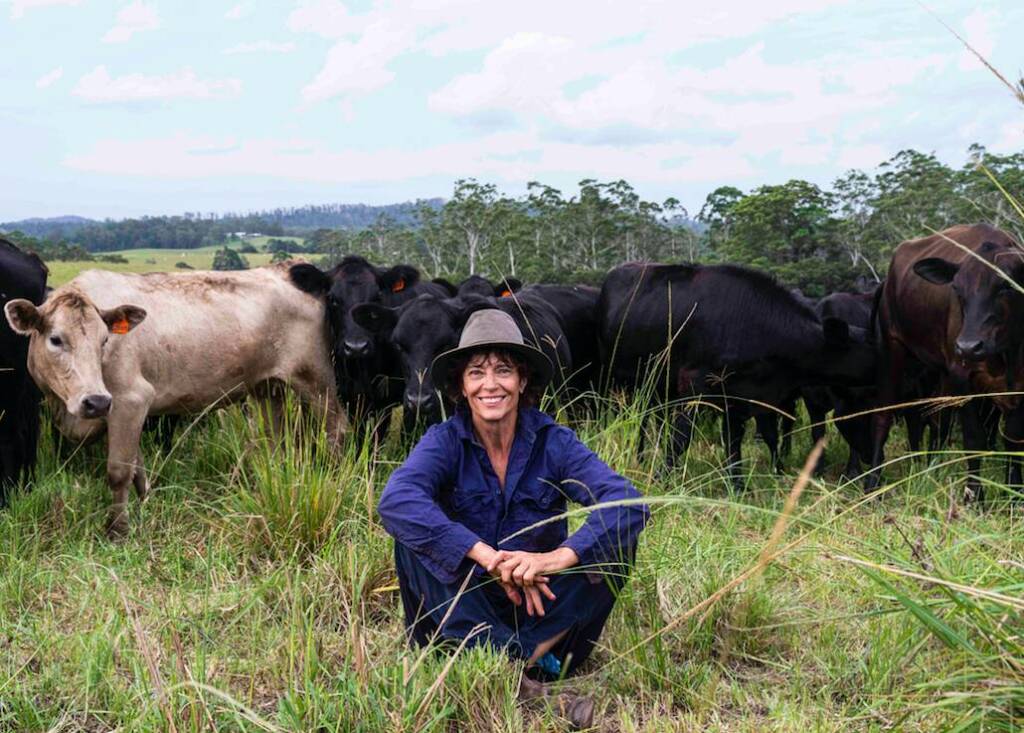FORWARD FOODING
THE BLOG
Going Beyond the Regenerative Agriculture Hype

In the countryside, a powerful revolution is underway. It embraces nature’s wisdom and forges a path away from conventional farming practices. In recent years, regenerative agriculture has garnered attention as a nature-friendly approach to farming and Agtech is amplifying its positive impacts while helping it overcome key issues.
At its core, regenerative agriculture strives to undo the damages of intensive farming, and rejuvenate and enhance farm ecosystems, while recognizing the interconnectedness of soil health, animals, and humans.
Multiple benefits from regenerative farming have led to an increasing wave of public and private interest and funding. However, it is not immune to greenwashing. The potential to solve pressing environmental and agricultural challenges is there. But a universal definition is not present. Regenerative agriculture is always context-specific, and a transparent system to implement and report is needed.
Why soil health matters
Agriculture has a recoil effect on climate and the environment. While agriculture is heavily affected by climate change, the way we farm and grow food can have destructive consequences on the land, water, and air around us. Practices like the use of chemical pesticides and fertilisers, as well as deforestation for farmland, harm soil, and water quality, and disrupt ecosystems, exacerbating climate change.
One such approach involves improving soil health through techniques like no-till farming, cover cropping, and biochar application. These methods restore land and improve efficiency, essential for sustainable agriculture. Perennial crops regrow after harvest, reclaiming abandoned land sustainably, while cover crops protect soil and stabilise yields, especially in unpredictable weather. Studies have shown that adopting regenerative farming techniques can outperform conventional methods, offering resilience to climate shocks and extreme weather events, and ensuring farmers can thrive even under challenging conditions. In essence, prioritising soil health is essential for sustainable agriculture and environmental stewardship.
What is regenerative agriculture
The context-specific nature of regenerative agriculture makes it difficult to have a single definition. But in simple terms, regenerative agriculture encompasses techniques that mimic natural processes to improve soil health, biodiversity, and ecosystem resilience. These practices include minimising soil disruption, maintaining soil coverage, fostering year-round live root systems, diverse crop rotations, and integrating livestock grazing. Farmers adhere to these principles to rejuvenate depleted soils, enhance fertility, and cultivate sustainable food.
Regenerative grazing, a component of regenerative agriculture, integrates livestock into crop rotations to improve soil health with nutrient-rich dung, creating closed-loop systems. By mimicking natural processes and reducing soil disturbance, regenerative agriculture helps restore soil, improve fertility, and sustainably produce food.

Google search volume of regenerative agriculture over the last decade (Source: Google Trends)
Hope, Hype, and Honest Transparency: Digging beneath the surface of regenerative agriculture
While the principles underlying regenerative agriculture are not novel, they are gaining traction as an increasingly favoured approach to combating climate change, particularly among major players in the food industry as the food sector is responsible for a third of global greenhouse gas emissions, and the private sector holds substantial sway over this system.
In 2022, a consortium comprising 12 food companies, including giants like Mars, PepsiCo, and McDonald’s, has unveiled a strategy to expand the utilisation of regenerative farmland. This initiative was disclosed just ahead of COP27 in Egypt. Last December, 26 organisations including Danone, Nestlé, PepsiCo, ADM, Unilever, Sysco and Olam Food Ingredients, announced at COP28 to be “collectively working to transition 160 million hectares of land” to regenerative agriculture by 2030.
Thus, regenerative agriculture has emerged as the perfectly proportioned sustainability solution for U.S. policymakers and companies alike. It strikes a balance, offering the allure of substantial change without causing too much discomfort as embracing regenerative agriculture offers a seamless transition for businesses, providing a sustainable option without disrupting existing supply chains. Moreover, its less controversial nature garners political support, allowing policymakers to address climate concerns without stirring conflicts.
Regenerative agriculture’s marketing appeal lies in its ability to showcase farmers as climate heroes, fostering heartwarming narratives of environmental stewardship and agricultural resilience.
How Agtech is Reshaping Regenerative Agriculture
As of today, there is a lack of scientific consensus regarding the extent to which existing methods can effectively trap atmospheric carbon, reliably measure, and thereby, contribute to climate change mitigation. But despite all that, regenerative practices are still significant. This gap is where Agtech-mediated solutions to regen ag may help address these key challenges.

Agtech solutions complementing regenerative agriculture encompass a diverse array of technologies aimed at enhancing soil health, optimising resource use, and fostering sustainable farming practices. Some common themes include:
- Precision Agriculture: Technologies such as smart sensors, drones, and data analytics enable precise monitoring and management of crops and soil health.
- Soil Health Monitoring, Intelligence, and Management: Technologies for real-time soil monitoring and intelligent fertilisation management, including soil sensors, drones, and satellite imagery
- Microbial Soil Health Improvement: Utilising beneficial microbes to enhance soil fertility and resilience.
- Soil Restoration and Carbon Sequestration: Solutions focused on restoring degraded soil and storing carbon through practices like biochar application and regenerative farming, biofertilizers, and soil carbon testing at scale.
- Regenerative Farming Platforms: Platforms integrating various regenerative practices and providing tools for farmers to implement sustainable techniques including a blockchain-based marketplace for regenerative farming.
- MRV Technologies: Monitoring, reporting, and verifying technologies play a crucial role in tracking carbon sequestration and other environmental benefits of regenerative farming practices.
- Agroforestry and Reforestation: Practices that integrate trees into farming systems for improved ecosystem health and carbon sequestration including agroforestry analytics
- Crop Management: Applying AI-powered algorithms for predictive crop modeling & drone tech for aerial crop monitoring.
- Livestock Management: Integrating IoT-enabled wearable devices and fences, satellite imagery for tracking.
These technologies collectively contribute to the advancement of regenerative agriculture by promoting soil health, reducing environmental impact, and fostering sustainable food production systems, while MRV technologies ensure the quantification and validation of environmental benefits.
The ‘Regen Ag Enablers’

While many of these practices are not new to farmers, what sets regenerative agriculture apart is the holistic integration of these practices into cohesive systems. By combining these techniques, farmers and entrepreneurs can unlock synergistic benefits that go beyond what individual practices can achieve alone. A few examples of startups in the regen Agtech business are:
Precision Agriculture:
- Arable (USA) – Offers precision agriculture solutions utilising smart sensors, drones, and data analytics for crop and soil management.
- Semios (Canada) – Provides precision agriculture solutions for monitoring and managing crops and soil health using advanced technologies.
- Trinity Agtech (USA) – Develops precision agriculture technologies for optimising farming operations and resource management.
- Boomitra (USA) – Provides precision agriculture solutions leveraging data analytics and technology to enhance crop management and yields.
Microbial Soil Health Improvement:
- BioConsortia (USA) – Specialises in using beneficial microbes to enhance soil fertility and resilience.
- Concentric Agriculture (USA) – Focuses on improving soil health through the application of beneficial microbes.
Soil Restoration and Carbon Sequestration:
- Soil Capital (Belgium) – Developing a certified, multi-national carbon payment program for farmers to earn revenue for mitigating climate impact.
- Husk (Cambodia) – Provides biochar-based fertilisers for soil restoration and carbon sequestration.
- AgriCarbon (UK) – Offers soil carbon testing services at scale to support soil restoration and carbon sequestration efforts.
- Enko (USA) – Offers innovative solutions in the field of sustainable agriculture, focusing on enhancing soil health and promoting eco-friendly farming practices.
Regenerative Farming Platforms:
- CIBO Technologies (USA) – Develops regenerative farming platforms integrating sustainable techniques for farmers.
- Nori (USA) – Operates a blockchain-based marketplace focused on regenerative farming practices.
- First Milk (United Kingdom) – Supports regenerative agriculture practices among dairy farmers, focusing on sustainable dairy production while prioritising soil health, biodiversity, and animal welfare.
MRV Technologies:
- FarmLab (Australia) – Provides monitoring, reporting, and verification solutions for tracking carbon sequestration and environmental benefits of regenerative farming.
- Smart Cloud Farming (Germany) – Combining satellite and ground data to assess the carbon sequestration potential of soils.
- Spatialise (Netherlands) – Offers MRV solutions for soil organic carbon monitoring and precision emissions verification in agriculture.
Agroforestry and Reforestation:
- Propagate Ventures (USA) – Specialises in agroforestry analytics and project development to integrate trees into farming systems for improved ecosystem health and carbon sequestration.
- Fa Bio (UK) – Specialises in agroforestry and reforestation projects to promote biodiversity and sustainable land management.
Soil Intelligence and Management:
- Sensegrass Inc (India) – Develops soil intelligence systems for real-time soil monitoring and intelligent fertilisation management.
- Verdi Technologies (Netherlands) – Providing diagnostic systems to help minimise the use of pesticides in agriculture.
Alternative Fertilisers
- Toopi Organics (France) – Collecting and processing human urine to extract nitrogen, phosphorus, and potassium for use as alternative fertilisers.
- Ekolive (Slovakia) – Producing biofertilizers as an alternative to traditional chemical fertilisers.
The Case for Regen Ag
Proponents advocate for its ability to restore degraded soils, enhance biodiversity, and mitigate climate change through natural farming practices. These methods, such as minimal soil disturbance and diverse crop rotations, have shown promise in rejuvenating ecosystems and promoting long-term soil health. However, critics raise concerns about the scalability and economic viability of regenerative agriculture, citing potential challenges in implementation and profitability for farmers. Additionally, while regenerative practices may offer environmental benefits, their effectiveness in addressing broader food system issues remains a topic of debate.
Despite the uncertainties, there’s growing momentum for regenerative agriculture and the potential for regen ag to transform agriculture into a more resilient system is undeniable. Yet, it’s essential to approach its adoption with a critical eye, acknowledging both its strengths and limitations. By carefully evaluating the nuanced impacts of regenerative practices, stakeholders can work towards a more holistic understanding of its role in shaping the future of agriculture.
Moving Forward: A Balanced Approach
The potential of regenerative agriculture to revolutionise our food systems and address pressing environmental challenges is undeniable. By leveraging its success, stakeholders can drive further improvements and adopt new tools to promote sustainability. By prioritising soil health, biodiversity, and ecosystem resilience, we can create a more sustainable and equitable food system for future generations.
With growing recognition from farmers, policymakers, and consumers alike, the momentum behind regenerative agriculture continues to build. The Agri-FoodTech industry should use regenerative agriculture’s success to drive more improvements. With its growing support and global awareness of food system reform, as now is the time for sustainability teams to adopt new tools.
Explore our Proprietary Taxonomy in our Macro Activity Spotlight on Agtech for further insights into the evolving landscape of agricultural technology. Learn more about the Agtech companies bolstering the positive impacts of regenerative agriculture through our Food Data Navigator and book a demo today.
Follow us
Sponsored Articles
8 February 2024
Future Food-Tech returns to San Francisco on March 21-22 Over 1,700 food-tech leaders, from CPG brands, retailers, ingredient providers, [...]
1 February 2023
The 4th edition of FoodTech 500 is taking off and we are excited to partner with NEOM for the third consecutive year to support the best international AgriFoodTech entrepreneurs.
10 February 2022
One of the elements we enjoy the most here at Forward Fooding about working with AgriFoodTech startups is being [...]
4 January 2022
At Forward Fooding, we believe in the power of innovation and collaboration to power the food tech revolution and transform [...]
27 April 2021
TWO Inc, a Tokyo-headquartered wellness company, has just launched its new “healthy junk food” concept to offer Japanese consumers nutritious [...]







